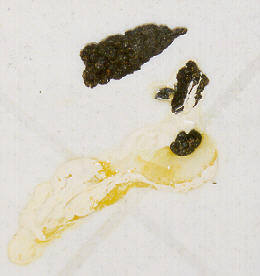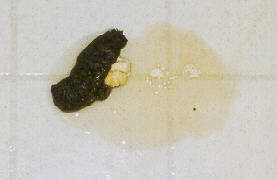
Melissa
Kaplan's
Herp Care Collection
Last updated
January 1, 2014
Feces and Urates
The scoop on the poop
©2000 Melissa Kaplan
Most new iguana keepers have never had reptiles before, or have had omnivorous or carnivorous reptiles. While there are strong similarities, iguana poop (the technical term used by ig keepers) seems to confound new iguana keepers.
Feces
Urates
Fecal Tests
Collecting Samples
Signs of Infestation
Photos
Feces
Iguana feces are composed of two parts - even though it looks like three,
sometimes. First is the fecal pellet, or mass. This should be dark brown
to black, evenly formed, soft but not to the point where it loses its
shape or form after it has been deposited. Small iguanas deposit pellets
that look rather like rabbit fecal pellets: a single, ovoid piece. As
they grow, the fecal mass grows, coming out twisted almost like a DNA
helix. An adult iguana's fecal mass rivals that of a small to medium size
dog. A healthy iguana's feces will smell fresh and green.
Urates
The other part of the waste is the liquid urates. It is generally clear
and somewhat viscous. Some days it may be more watery than others. Depending
upon what has been eaten the day or so before, such as raspberries, carrots,
or cactus pear, the urates may be tinged with red. The other part of the
urates is a white stringy mass that sometimes can be seen in the urates,
while other times in may be inside the fecal mass or threaded through
or around it. If the urates every are greatly reduced in quantity and
very thick and yellow, it indicates that the iguana is dehydrated or that
there may be other problems going on that may require a veterinarian's
attention.
Fecal
Tests
One of the
first things an iguana keeper needs to do is to get their new iguana checked
for internal parasites. While there are many organisms that inhabit the
iguana gut, and many of them serve a vital role in digesting food, some
are not so friendly or beneficial. When healthy and relatively stress-free,
the beneficial organisms keep the others under control, keeping their
numbers down. When an iguana is sick, stressed, or not kept properly over
a prolonged period of time, the balance changes, with the non-beneficial
organism gaining ascendancy. Since these organisms are microscopic, and
generally only their even tinier eggs are passed down the digestive tract
to be mingled with the feces, they cannot be seen with the unaided eye,
so you cannot tell just by looking at the iguana's feces whether it has
problematic loads of parasites that need to be attended too.
Fecal Flotation
The primary
fecal test you will have done is a fecal flotation. This checks the feces
for the presence of worm ova. Worms live out their adult life cycle inside
the host animal, releasing their eggs to be deposited wherever the animal
defecates. Other animals coming into contact with the feces then ingest
the eggs (referred to as oral-fecal transmission), thus giving the ova
a nice place to hatch and set up housekeeping. The flotation requires
a fresh sample of feces--the brown fecal mass, not the clear viscous or
white urates. The vet or vet technician mixes the feces in a special solution
in the testing container. A microscope slide is placed on top to trap
any ova which, being lighter than the solution, will float to the top.
The vet or veterinary technician will then look at the slide under a microscope
to determine if and what kind of ova there are so that the proper medication
can be administered.
Direct Smear
If your iguana has loose feces, diarrhea, or the feces are very smelly
(you can smell it walking in the door of the room - or the house), your
iguana may have a protozoan infection. When doing this test, the veterinarian
or technician mixes a portion of the fecal sample with a fluid, and then
smear the mixture directly onto a microscope slide; this test is called
a direct smear. The veterinarian or vet tech will examine the smear to
see if there are any protozoans present. Medication will be administered
depending upon the type of organism found.
Collecting
Samples for Testing
The safest and
neatest way to collect a fecal sample is to turn a clean (not previously
used) zip-lock plastic bag inside out over your hand. With your fingers
and thumb protected by the plastic, use them to scoop up the brown fecal
mass*. While holding the feces in your grasp, use your other hand to pull
the zip-lock edge of the bag down and over your hands, turning the bag
right-side out. Your grasping hand will now be outside the bag and the
feces inside.
Zip up the bag, and place that bag inside another zipped bag. With a marker or on a label you stick to the bag, write the date, the iguana's name, and its species ("green iguana").
You can store the fecal sample in a cool place for up to four hours before delivering it to the vet. You can store it overnight in the refrigerator if you need to. Since excess heat or cold can kill the organisms in the feces, thus defeating your purpose for collecting it to begin with, don't freeze it, or leave it in your car on even a mildly warm day.
If you are not able to get a fecal sample to take with you on your visit to the vet, ask the vet if is will be okay to drop off a sample as soon as you get one. This should be fine with the vet. Neither you nor the iguana need to be there when the sample is actually tested. Since the vet will measure and weigh your iguana during your visit, if your iguana needs to be treated for worms, the vet will be able to calculate the dosage and measure out the amount you will need for the 2-3 doses needed. You can then pick up the medication and administer it home. Or, you can bring the iguana back to the vet for the first dose so you can see how it is done. You can then administer the subsequent doses at home on your own.
*When collecting a fecal sample to take to the vet, be sure you scoop up the feces, not just urates, and not mostly urates. Even the small, raisin-sized fecal pellets deposited by hatchling iguanas can be tested for parasites.
Signs
of Parasite and Protozoan Problems
Most of the time,
the fact that the iguana has a clinically serious infestation of parasites
and protozoans is not evident by looking at the feces as you go to clean
them up. There may be little to no change in color, odor, consistency
or size. The most common signs that indicate a test is required are
-
Change in color and/or consistency of feces, not related to diet or breeding season
-
Rusty or orange tinge to the urates, not related to diet or breeding season
-
Appearance of poorly digested food in the feces, not related to environmental heat problems.
-
Near-normal appearing feces with a very strong, unpleasant odor. (Some people find the odor of healthy iguana feces to be unpleasant; the odor associated with Giardia infections is nothing like the smell of healthy feces.)
Since stress can cause problems in the normal gut flora, it makes sense to have your established iguana checked out after they have had a couple of weeks or a month to recover from a major stress event (all newly acquired hatchling and juvenile iguanas should be fecal tested within the first two weeks of acquisition). Events such as moving from one home to another, even if the move doesn't involve a change in the humans they belong to, is a good idea, as moving is highly stressful to them. Significant changes in the household can also cause enough stress to result in gut flora imbalance.
Photos
The following
are photos of normal iguana poop--the feces and urates. Note that the
liquidity/viscosity of urates may vary by day or season depending on how
much fluid the iguana takes in, either by drinking or the water content
of the foods being fed.
|
During breeding season, it is not uncommon to find seminal deposits mixed in with the urates, as is easily seen in this photo of feces/urates/ejaculate from a green iguana. |
Normal iguana poop. The fecal mass has maintained its integrity, and both the white and clear-ish urates can be seen. The color of the "clear" part of the urates may vary depending on what is being fed (high levels of red and orange plant matter can tinge the urates orange or reddish). Color may also be affected by certain parasite infections (reddish/rust) and by dehydration (orange/yellow). The white part of the urates may form soft clumps and may be laced through the feces or clear urates. The feces/urates pictured above are from a Cyclura iguana; being an omnivore, their white urates are a little more clumpy than in the herbivorous green iguanas.
|
Related Articles

